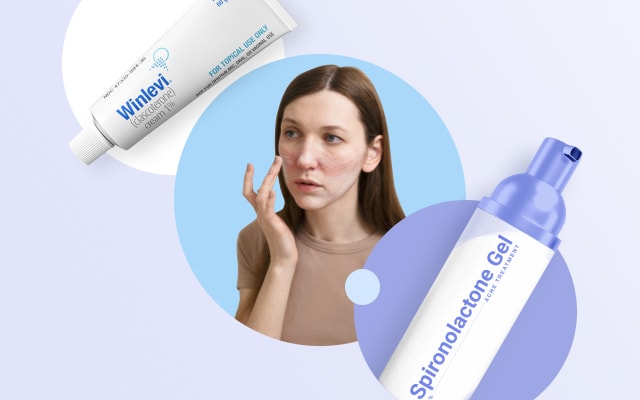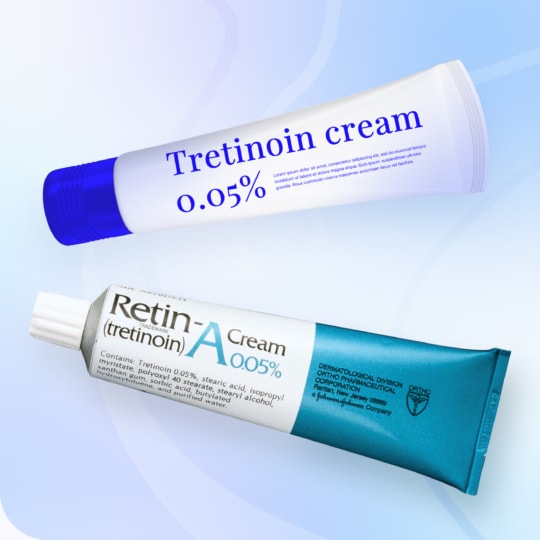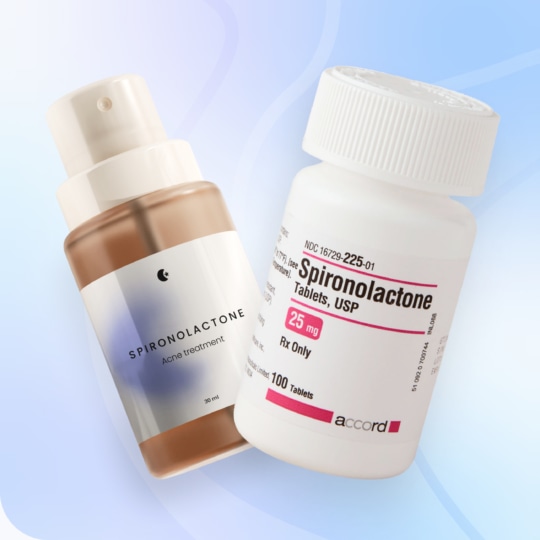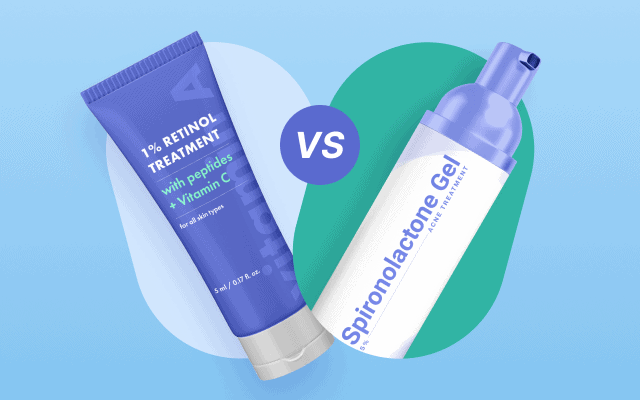A dermatologist’s guide on a skincare routine for acne
A dermatologist’s guide to building the best morning and evening skincare routine for acne.
Covered in this article:
What is a skin care routine for acne? | Why should I have one? | When to add prescription medications? | Key ingredients for a skincare routine | Basic morning skincare routine | Simple night skincare routine | |Hormonal acne
Acne is the most common dermatological skin condition, and it will affect most people during their lifetime. It affects up to 85% of young adults and teenagers, but for some, it can continue till later in life, especially women1. Luckily, you can considerably improve your skin’s condition with a few acne self-care measures and a good skincare routine.
What is a skincare routine for acne?
A skincare routine can be defined as a series of steps you take to care for your skin regularly. Any skincare routine aims to improve and maintain healthier skin for longer and target specific problem areas.
A skincare routine is a regular process using specific products to care for your skin.
There is no general solution for all skin types. Each person is different and requires individual care. But, there are some general guidelines to help create a process that will promote healthier skin. Let’s look at some of the basics of acne and how to help prevent and treat it.
Why should you have a skincare routine for acne?
Almost everyone will experience acne at some point5. The condition tends to appear most during adolescence, but it can affect all ages, genders, and ethnicities.
During puberty, the androgenic spike increase the production of sebum which contributes to the clogging of pores6. Acne can be more severe in some people because of genetics, hormones, environmental factors, or medications. There’s ongoing research into triggers, but studies show that while certain factors don’t cause acne, they can exacerbate the condition. Stress, seborrhea or makeup products, certain foods, sleep deprivation, and smoking worsen acne7.
In women, the hormonal changes present at puberty, the menstrual cycle, pregnancy and menopause change the skin8.
Acne caused by hormonal changes can be very difficult to treat with over-the-counter products and may require a combination of prescription medications such as an androgen blocker (spironolactone or clascoterone), retinoids (tretinoin, adapalene, tazarotene, trifarotene) or antibiotics (such as clindamycin, doxycycline).
Besides, since skin becomes thinner with age, prescription retinoids can be especially beneficial to stimulate cellular turnover.
For adult men, facial hair can also trap oil and bacteria and shaving can aggravate inflammation9. Men need to understand the importance of an acne regimen to protect their skin as much as women do.
When to add prescription medication to an acne skincare routine?
“If you are not happy with the results obtained from your over-the-counter acne products, your should consult a dermatologist before your acne becomes worse as early intervention is essential to avoid acne scarring and post-inflammatory hyperpigmentation,” says Dr. Fernandez.
“Depending on the type and severity of the acne, I recommend skipping over-the-counter products altogether because they are limited,” says Dr. Fernandez. While retinol can have positive effects, over-the-counter products usually contain a low percent of retinol. A prescription-strength retinoid such as tretinoin or adapalene is much more effective, but needs medical supervision. “Besides, it can also be beneficial to use oral medications (such as minocycline, doxycycline or spironolactone) or for medium to severe acne or when other products have shown no results,” she added.
Dr. Fernandez recommends that women who are pregnant, may become pregnant, or are breastfeeding should always consult with a dermatologist when treating acne to ensure the products are not teratogenic and don’t harm the fetus.
Key ingredients for a basic acne skincare routine
“It might be difficult to develop a good skincare routine for acne because there are so many products available on the market and so much information about product application order,” says Dr. Carolina Fernandez, Dermatologist.
“However, you don’t need a very complex regimen to manage your acne. A simple daily skincare regime may reduce acne considerably. It is also important to include sunscreen in this routine, as you should always be protected from UVA and UVB rays,” added Dr. Fernandez.
Several cleansers and moisturizers are available as supplemental therapies for acne-prone skin, including lipid-free cleansers with a low risk of skin irritation and moisturizers containing ingredients such as humectants (to keep things moist), emollients, oil absorbers, and those with anti-inflammatory and barrier replenishing properties.
According to Dr. Fernandez, some of the first-line treatments for acne include:
- Tretinoin – A prescription-strength retinoid that increases cell turnover, prevents clogged pores, and reduces acne, making it a powerful treatment for both acne and post-acne scarring.
- Salicylic Acid – A beta hydroxy acid (BHA) that exfoliates the skin, removes excess oil, and helps clear pores, reducing the occurrence of blackheads and white heads.
- Benzoyl Peroxide – An antibacterial agent that kills acne-causing bacteria and reduces inflammation, helping to treat active breakouts and prevent new ones.
- Niacinamide – A form of Vitamin B3 that calms inflammation, controls oil production, and strengthens the skin barrier, making it suitable for sensitive, acne-prone skin.
- Hyaluronic Acid – A hydrating ingredient that replenishes moisture, which is particularly important when using potentially drying acne treatments like retinoids or benzoyl peroxide.
- Non-comedogenic Moisturizer – Hydrates the skin without clogging pores, ensuring skin stays balanced and hydrated while using acne treatments that can dry out the skin.
“Remember that many of these first-line treatments cannot be used at the same time and some of them, are not suitable for use in children, or cannot be used during pregnancy or lactation. That is why the treatment must be carried out under the supervision of a qualified health professional,” said Dr. Fernandez.
Steps in a DIY Skincare Routine
According to Dr. Fernandez, if you want to clear your skin from acne, you should consider morning and night skincare routines – with specific steps for each of them. Just a few minutes twice daily will be sufficient.
It’s important to apply acne treatment as directed by your dermatology provider, whether it’s morning, evening, or both, to be effective.
While different skin types require different products, the application order is also important for the acne skincare routine to be effective.
Basic morning skincare routine
According to Dr. Fernandez, these skin care steps are enough to offer protection in the morning:
Step 1. Wash your face – Use a gel-based cleanser for oily skin, and a cream-based cleanser for normal to dry skin. Rinse your face with warm water.
Step 2. Moisturize your skin – Hydrate your skin with a formula suitable for your skin type; for oily skin, use oil-free or gel products with humectants like glycerin and hyaluronic acid.
Step 3. Apply sunscreen – Use a non-comedogenic sunscreen daily, even during the winter. Reapply every two hours if you are outdoors. Your sunscreen should have an SPF 50+ to protect against UVA and UVB rays and blue light.
Simple night skincare routine
At night, there are a few more steps to cleanse and repair:
Step 1. Remove your makeup and wash your face – Use a gentle make-up remover to remove all traces of makeup, then wash your face with a gentle cleanser that does not contain benzoyl peroxide nor exfoliants.
Step 2. Apply a retinol product – Apply the product to the entire problem area to help get rid of the pimples you have and prevent new pimples from developing.
Step 3. Apply a moisturizer – Most effective when applied to slightly damp skin to help prevent skin from drying out.
Step 4. Use an acne spot treatment – This can be applied as a leave-on treatment to help speed healing.
Dr. Fernandez also recommends washing your face after working out, as sweat can clog pores and aggravate acne.
She also recommends you adjust your skincare routine because in winter, you may need a stronger moisturizer, and in summer, you will need to constantly reapply sunscreen.
What products can I use in a skin care routine for hormonal acne?
“Patients with hormonal acne can benefit from a skin care regimen that includes some of the same ingredients as with acne vulgaris, but adding a topical or oral androgen blocker such as spironolactone can make a huge difference in the results of the treatment, always under supervision by a qualified healthcare professional”, she added.
Conclusion
In conclusion, following a consistent morning and evening skincare routine is essential for managing acne. A good skincare routine should include cleansing, moisturizing, and protection from the sun.
It is also important to use products that are appropriate for your skin type and to avoid harsh ingredients that can irritate the skin.
Additionally, incorporating prescription medications can help address acne that has not cleared after a few weeks.
Remember to be consistent with your skincare routine, as it can take time to see results. By following these tips and working with a dermatologist, you can achieve clearer, healthier-looking skin.
References:
1 https://www.aad.org/media/stats-numbers
2 https://www.ncbi.nlm.nih.gov/pmc/articles/PMC3969667/
3 https://www.ncbi.nlm.nih.gov/pmc/articles/PMC7527424/
4 https://www.researchgate.net/publication/7289458_A_re-evaluation_of_the_comedogenicity_concept
5 https://www.aad.org/media/stats-numbers
6 https://www.ncbi.nlm.nih.gov/pmc/articles/PMC3969667/
7 https://www.ncbi.nlm.nih.gov/pmc/articles/PMC7527424/
8 https://www.ncbi.nlm.nih.gov/pmc/articles/PMC3969667/
9 https://www.aad.org/public/everyday-care/skin-care-secrets/face/diy-treatment-common-beard-problems
Skin conditions and treatments
Articles written in collaboration with dermatologists
Facial treatment for seborrheic dermatitis
How to get rid of rosacea permanently?
How to calm a rosacea flare-up fast?
Spongiotic dermatitis: What is it and what is the best treatment?






